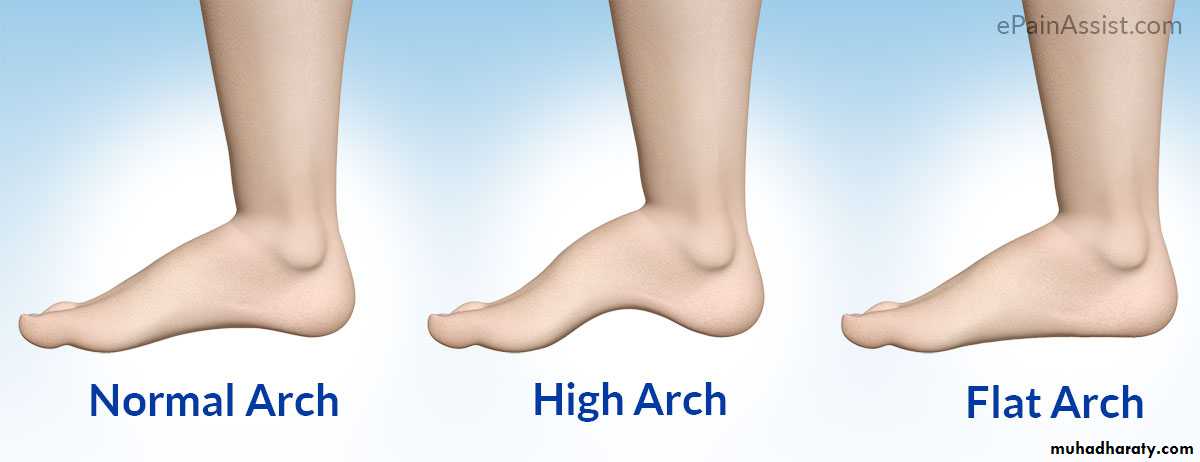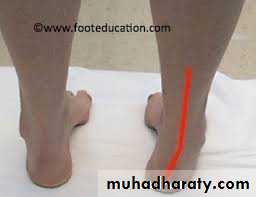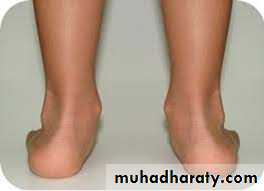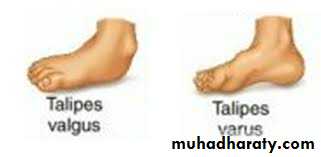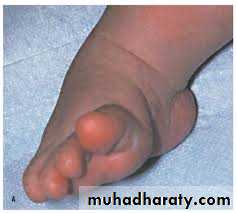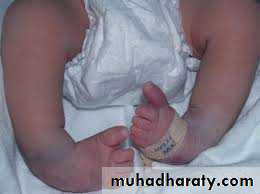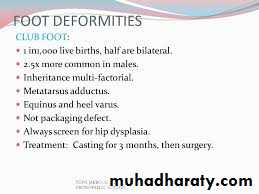• Regional Orthopedic ankle and foot Regional Orthopedic of ankle & foot ByASS.Prof. Dr.ZaidShahwanii
Deformities of ankle and foot:
Most of those occur due to:1. Congenital defects.
2. Muscle imbalance.
3. Ligament laxity.
4. Joint instability.
Equinous foot: the foot is planter flexed at the ankle.
Calcaneus foot: the foot is dorsiflexed at the ankle.Varus foot; is like an inverted foot with the sole facing medially Valgus foot; is like an everted foot with the sole facing laterally
Flat foot (pes planus): is the condition where there is flattening of the medial longitudinal arch of the foot and this is usually associated with valgus deformity. Pes cavus: it is the deformity where there is increased medial arch of the foot and this is usually associated with varus deformity and claw toes Clawing of the toes: is the deformity where there is abnormally maintained hyper¬extension of the metatarso-phalangial joints and flexion of the interphalangial joints. Hallux valgus (Hallux is the big toe): is an abnormal lateral deviation of the big toe.
Talipes: it means any deformity where the foot is no more in plantigrade position, its usually congenital and the most frequently seen in practice is the cogenital talipes eqinovarus.
Planti grade
Pes cavus
Pes planus
Calcano varus
Calcano valgusCogenital Talipes Equino varus Cong. Club foot by Ass. Prof.Dr. Zaid al-shahwanii
Tali–ankle ,,pes -foot, i.e a congenital deformity of the ankle and foot where the foot is twisted and fixed in an abnormal position.It is present at birth ,Incidence Ratio 1 in 1000 births.
more common in males as twice as females ,,and can affect both feet in 50% bilateral of the cases ,
Pathological anatomy
1) The deformity is mostly in the talus & in the calcanum were they point down wards & inwards ,,,,
2) The navicular with the entire fore-foot are shifted medially and rotated in supination so that the whole foot is pointing down and twisted inwards at the ankle, and tends to be smaller than normal…
Causes most commonly, it is an isolated congenital birth defect and the cause is idiopathic (unknown). …But it is believed to be a "multifactorial trait" meaning that there are many different factors involved,,,, the majority of clubfeet result from the abnormal development of the muscles, tendons, and bones, while the fetus is forming in the uterus during the first trimester of pregnancy (about the 8-12 week).
If both parents are normal with an affected child, the risk of the next child having a clubfoot is 2-5%.
There is also an increased risk for clubfoot associated with certain diseas such as 1)neurogenic conditions (spina bifida, cerebral palsy , arthrogryposis),2) connective tissue disorders ( diastrophic dwarfism), ,,,and 3)mechanical conditions (oligohydramnios, congenital constriction bands). The foot deformity seen with the above conditions is often more severe and often requires early surgical correction.
Clinical feature
Ankle is equines , fore foot adducted & supinated ,so the sole of the foot faces medially , the heel is small & high up with thin ,small calf muscle.Diagnosis
Clubfoot is easily diagnosed clinically during the initial physical examination of the newborn. Often times, the diagnosis of clubfoot can now be made prenatally during the 16-week by ultrasound. If the diagnosis is made prenatally, we encourage the parent to schedule an appointment in the pediatric orthopaedic clinic to discuss diagnosis and treatment options available.
…X-Ray taken to confirm the diagnosis .by detecting the talo-calcanium angle in dorsi flexed foot
Treatment\\ Aims A) to correct the deformity early
B)to correct the deformity fullyC)to preserve the correction till
the foot stop growing .
Although each child is different, treatment for clubfoot usually begins immediately after diagnosis. It is important to treat clubfoot as early as possible (shortly after birth). .
Clubfoot must be treated,,,as it does not correct itself …If left untreated, the deformity will not go away. It will continue to get worse over time, with secondary bony changes developing over years. An uncorrected clubfoot in the older child or adult is very disabling. Because of the abnormal development of the foot, the patient will walk on the outside of his/her foot which is not designed for weight-bearing
Methods of treatment
1) stretching & splintingTreatment usually starts soon after birth by stretching & manipulation and with a series of castings and splinting as in the passive easly corrected non – resisted clud foot,, treatment involves serial manipulation and plaster casting of the clubfoot. The ligaments and tendons of the foot are gently stretched with weekly, gently manipulations. A plaster cast is then applied after each weekly sessions to retain the degree of correction obtained and to soften the ligaments this procedure continue for 6-8 weeks.. Thereby, the displaced bones are gradually brought into the correct alignment. Four to five long leg (from the toes to the hip) are applied with the knee at a right angle. ponsitti methods))
2) operative Treatment
Specially for the rigid resisted type of clud foot , (( Turco operation )) through postro –medial incision Z-plasty elongation of the contracted & shortened tendo achillis & posterior tibial tendon + ligaments and soft tissue release on the medial side of the foot may be required. Fellow by casting with p.o.p above knee joint for 6-8 weeks then a night splint (( Denis brown )) for one year. This will do for a child with an age below 5 years .
If the deformity persist in a child above 5 years of age,, bone reshaping should be done ,,while the Treatment of neglected club feet with age over 10 years, is by lateral wedge osteotmy or triple arthrodesis in mature neglected clubfoot.

